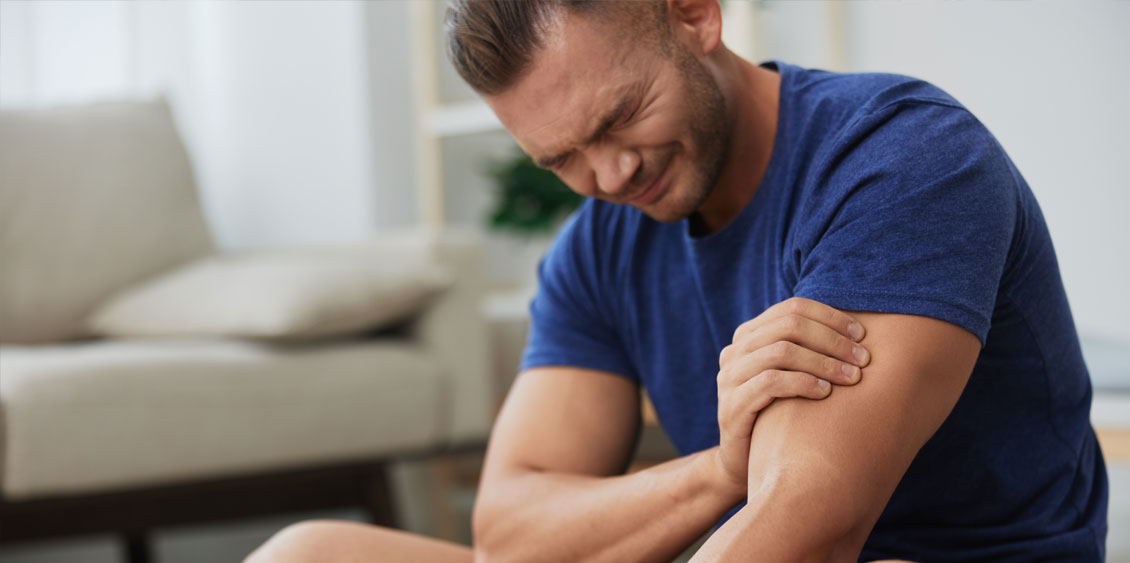Whether mild or intense, temporary or persistent, muscle pain can quickly disrupt your daily routine. Here are a few tips to help you recognize, prevent, and relieve it.

What is muscle pain?
Everyone experiences muscle pain, be it after intense exertion, a bad night’s sleep, or even for no apparent reason. Muscle pain can be limited to the legs, arms, or back or more widespread. It can occur at any age and is not always related to physical activity.
Did you know? Muscle pain is different from arthritis pain. To find out more, read our article on this topic.
What are the possible causes of muscle pain?
Also known as myalgia, muscle pain can appear without warning and have multiple causes:
- Intense or unusual physical effort, especially when muscles were not properly warmed up.
- Built-up muscle tension from repetitive movements.
- Poor posture caused by sitting in front of a screen for long periods or carrying a heavy object incorrectly, for instance.
- Stress can also play a large role. When you’re stressed, your muscles are too.
- Viral infections, such as colds and the flu, that are often accompanied by aches and pains.
- Certain chronic illnesses, such as fibromyalgia or neurological disorders.
Sometimes, hormones can also play a role. For example, hypothyroidism can cause muscle pain. To find out more, read our article on this topic.
What are the warning signs?
Muscle pain is common... but it doesn’t have to be commonplace. Listen to your body and don’t ignore the following signs:
- Pain that lasts more than a few days
- Pain that is so intense as to restrict movement
- Pain accompanied by fever, redness, swelling, or unusual weakness
These signs may indicate an infection or other problem that requires medical attention.
How can you tell the difference between muscle pain and joint and heart pain?
Muscle pain is often related to movement or effort and diminishes with rest. It manifests as an aching sensation or tension. Joint pain, on the other hand, affects joints such as knees, wrists, or fingers. It may be accompanied by stiffness, swelling, or cracking and sometimes persists even when resting.
Cardiac pain is more serious. Often manifesting as pressure or a vise-like sensation in the chest, it sometimes radiates into the left arm, neck, or jaw and may be accompanied by shortness of breath or nausea. If you experience chest pain with no explanation, it’s important to seek prompt medical attention.
What is fibromyalgia?
Fibromyalgia is a poorly understood but very real condition. While characterized by chronic pain diffused throughout the body, it is not caused by inflammation or injury.
What causes fibromyalgia?
Imagine amplified pain signals when there is no injury or apparent cause. Fibromyalgia causes the nervous system to overreact to certain messages. This very real physical reaction feels as though the body is permanently on edge.
What are the symptoms of fibromyalgia?
Initial symptoms may vary from one person to another, but some recur frequently:
- Constant muscle pain
- Morning stiffness
- Extreme sensitivity to touch in certain areas of the body
- Fatigue that doesn’t go away, even after a good night’s sleep
- Digestive problems
- Unstable mood and difficulty concentrating
Important: If these symptoms persist and affect your quality of life, it’s important to talk to a health care professional. Putting words to what you’re going through is the first step in getting better.
Should you apply heat or cold to muscles?
It all depends on the pain’s origin and timing. In general, apply cold as soon as pain occurs, just after an injury or overexertion. For example, if you pull a muscle while exercising, apply a cold compress for 10 to 15 minutes to help ease the pain.
Warmth is good for stiff or tense muscles, as it helps relax tissues and stimulate blood circulation.
Simple ways to relieve muscle pain
Getting better doesn’t necessarily require complex treatments. Often, the simplest gestures provide the most effective relief. If pain persists, however, there are products, treatments, and professional support to help you resume daily activities with greater ease.
What simple daily habits can help?
Balance is key, so don’t force yourself through a workout or forgo all activity.
- Rest, but stay active at a lower level. Moving gently, at your own pace, helps release tension without aggravating pain.
- Proper hydration helps eliminate toxins and aids recovery.
- Light stretching, especially after activity or in the morning, releases tension.
- Self-massage, either by hand or with a roller, can do wonders for muscle relaxation.
What drugs or products can I use to relax my muscles?
You’ll find a number of different options at Brunet:
- Creams and gels with a heating effect
- Magnesium supplements, if a deficiency is suspected
- Natural arnica-based products for local relief
Tip: Still experiencing discomfort? Your pharmacist is there to listen and help you find solutions adapted to your situation.
How can I prevent pain caused by vitamin and mineral deficiencies?
Magnesium, vitamin D, and vitamin B12 play an essential role in your body, notably in muscle contraction, recovery, and nerve transmission. An imbalance can disrupt these processes. To learn more about strengthening your immune system and preventing muscular pain, read our article.
Did you know? A simple blood test, prescribed by a health professional, can check your levels. In cases of deficiency, supplements and dietary changes may be suggested.
What foods can help prevent muscle tension?
- Fatty fish
- Eggs
- Vitamin D–fortified dairy products
- Meat and offal
- Legumes for vitamin B12
An ounce of prevention is worth a pound of cure: Healthy habits for caring for your muscles
Can gentle physical activity help?
Yes, daily exercise is the best way to keep your muscles healthy. Don’t overdo it, however. A daily walk, gentle cycling, swimming, or yoga is all you need to maintain flexibility and muscle strength.
What simple stretches can you incorporate into your routine?
A few minutes of stretching in the morning or after physical activity can reduce tension. Examples include reaching your arms up toward the ceiling, gently stretching your legs, and rotating your shoulders.
Can diet support muscular health?
Yes! A varied, balanced diet, rich in proteins (meat, fish, eggs, tofu, legumes), vitamins (fruit, vegetables), and minerals (such as magnesium), promotes muscle repair and health.
What natural supplements could help?
Products containing magnesium, turmeric, or calming herbs can be a good complementary treatment. Always ask your pharmacist for advice on whether these products are right for you.
While common, muscle aches and pains should not be ignored. We advise listening to your body and adopting good daily habits, such as moving at your own pace, staying well hydrated, and stretching regularly.
If you experience persistent or unusual pain, talk to your pharmacist. Your health care professionals are there to listen and support you.
Other articles that might interest you
Arthritis pain: How to recognize and relieve it
Hypothyroidism: when the body’s metabolism slows down
5 tips to boost your immune system
How physical activity aids our immune system: Can exercise help prevent us from getting sick?
Last updated on May 27, 2025

